Edson Pavoni
What we cannot forget
exhibition + performance / 2023
What we cannot forget was
Edson Pavoni's first solo exhibition. Curated by Carollina Lauriano,
the exhibition was the result of three years of research by the artist on themes involving
loss, memory and grief, with an emphasis on the Covid-19 pandemic. The exhibition is
a development of the Inumeráveis Memorial project, which brings together thousands
of stories of the victims of the coronavirus in Brazil since 2020.
The exhibition was also the stage for a performance with the same title, starring Pavoni and artist Isabella Nardini, on the day of its opening. In the following day, the exhibition featured a conversation with the curator, the artist, and with Ana Claudia Quintana, a doctor specialized in palliative care. The exhibition was on display between June 17 and 18, 2023, at Casa Cósmica, in São Paulo.
The exhibition was also the stage for a performance with the same title, starring Pavoni and artist Isabella Nardini, on the day of its opening. In the following day, the exhibition featured a conversation with the curator, the artist, and with Ana Claudia Quintana, a doctor specialized in palliative care. The exhibition was on display between June 17 and 18, 2023, at Casa Cósmica, in São Paulo.
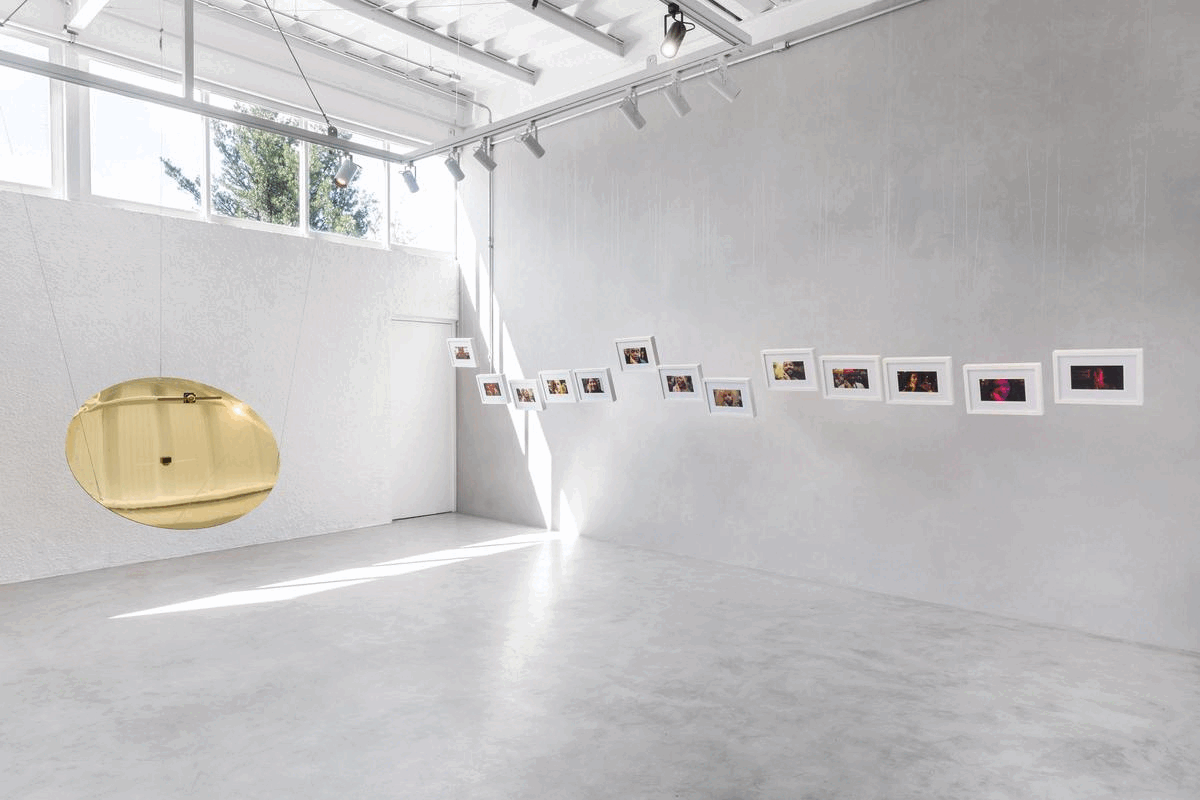
What we cannot forget, 2023.
Images by Estúdio Em Obra.
Images by Estúdio Em Obra.
The scream, the silence and the music
“Taking the crossings that the pandemic imposed on the world, but also pointing out issues of a political nature faced by Brazil in the struggle against the virus, Edson Pavoni presents a set of works that one on hand denounce negligence committed on the part of the government, and on the other choose poetic paths that point to ways of elaboration of futures, in an attempt not to let us forget the nearly seven million fatal victims of the virus worldwide, among them more than seven hundred thousand Brazilians”, writes Lauriano.
The three parts of the exhibition — the scream, the silence and the music — are understood by the artist as three stages for the elaboration of mourning. “If in a scream, Pavoni makes use of primary feelings — such as anger — to dealing with this first moment of absence, silence acts as the next step of recollection and introspection”, explains the curator.
Leaving that moment, for the artist, requires a period of contemplation: silence. A period of calm, of introspection. A break to process the pain. According to the curator, when we can overcome these “two moments of difficult assimilation”, it is possible to hear the music that opens new paths. Thus, “Pavoni brings us to life. Or the possibility of it.” Given the long periods of isolation caused by the pandemic, the moment of music, in this exhibition, brings references linked to touch, physical contact, and the nuances of human connections. In his works, Pavoni demonstrates “that it is possible to reactivate memories that take us out of the state of isolation and put us back in touch with the world”, as Lauriano elaborates.
Read the curator's full text here.
“Taking the crossings that the pandemic imposed on the world, but also pointing out issues of a political nature faced by Brazil in the struggle against the virus, Edson Pavoni presents a set of works that one on hand denounce negligence committed on the part of the government, and on the other choose poetic paths that point to ways of elaboration of futures, in an attempt not to let us forget the nearly seven million fatal victims of the virus worldwide, among them more than seven hundred thousand Brazilians”, writes Lauriano.
The three parts of the exhibition — the scream, the silence and the music — are understood by the artist as three stages for the elaboration of mourning. “If in a scream, Pavoni makes use of primary feelings — such as anger — to dealing with this first moment of absence, silence acts as the next step of recollection and introspection”, explains the curator.
Leaving that moment, for the artist, requires a period of contemplation: silence. A period of calm, of introspection. A break to process the pain. According to the curator, when we can overcome these “two moments of difficult assimilation”, it is possible to hear the music that opens new paths. Thus, “Pavoni brings us to life. Or the possibility of it.” Given the long periods of isolation caused by the pandemic, the moment of music, in this exhibition, brings references linked to touch, physical contact, and the nuances of human connections. In his works, Pavoni demonstrates “that it is possible to reactivate memories that take us out of the state of isolation and put us back in touch with the world”, as Lauriano elaborates.
Read the curator's full text here.

What we cannot forget. Views of the exhibition.
Photograph by Estúdio Em Obra.
Photograph by Estúdio Em Obra.
The scream
According to the palliative care specialist, Ana Claudia Quintana, “what we experienced in the pandemic still should be in the space of the scream”. In her text on the exhibition, Quintana describes this space as a place “of the shock, the indignation, the perception of the injustice of hands given with irreversibility. No death is less than one hundred percent absence. Of abysmal, profound, total silence. Of the voice of those who left around the listening ears of those who remained. This deafening silence is only broken by the sound of nature. The nature that reveals the persistence of life every day. The stubbornness of life. The determination of life. That at your pace, tirelessly, persistently and lovingly comes and shows us that the rhythm of life goes on.”
Read Ana Claudia Quintana's full text here.
According to the palliative care specialist, Ana Claudia Quintana, “what we experienced in the pandemic still should be in the space of the scream”. In her text on the exhibition, Quintana describes this space as a place “of the shock, the indignation, the perception of the injustice of hands given with irreversibility. No death is less than one hundred percent absence. Of abysmal, profound, total silence. Of the voice of those who left around the listening ears of those who remained. This deafening silence is only broken by the sound of nature. The nature that reveals the persistence of life every day. The stubbornness of life. The determination of life. That at your pace, tirelessly, persistently and lovingly comes and shows us that the rhythm of life goes on.”
Read Ana Claudia Quintana's full text here.

Chloroquine, 2023, part of the series Checked Headlines.
Photograph by Estúdio em Obra.
Photograph by Estúdio em Obra.
Em Grito, a série Checked Headlines
takes as a starting point
the scandals that marked the peak period of the pandemic
of Covid-19, denouncing its effects and consequences for
Brazilian population. It is made of three works: Chloroquine, Viagra and One Dollar, all from 2023.
During this period, the explosion of disinformation that promoted medication proven ineffective for the disease's prevention and prophylaxis. Medical authorities, religious organizations and even the head of government disseminated the promotion of pharmaceuticals such as Chloroquine and Ivermectin, directly impacting the lives of thousands of Brazilians, leading to disastrous results for the control of the virus.(1)
During this period, the explosion of disinformation that promoted medication proven ineffective for the disease's prevention and prophylaxis. Medical authorities, religious organizations and even the head of government disseminated the promotion of pharmaceuticals such as Chloroquine and Ivermectin, directly impacting the lives of thousands of Brazilians, leading to disastrous results for the control of the virus.(1)

One dollar, 2023, part of the series Checked Headlines.
Photograph by Estúdio em Obra.
Photograph by Estúdio em Obra.
And as the world engaged in a vaccine race,
one that was effective and safe, the Brazilian government found itself in the midst of accusations
which demonstrated their efforts in not securing vaccines as soon as possible.
Their goal was to profit one dollar per dose
bought with the Davati Medical Supply company.(2)
As if that were not enough, reports proved that the Brazilian Armed Forces had used public money to acquire more than 35 thousand units of sildenafil, a medicine known by the commercial name of Viagra. Moreover, it was bought with the implausible justification that it would be used in the treatment of military personnel with uma rare disease called pulmonary arterial hypertension which affects more women than men, among other inconsistencies.(3)




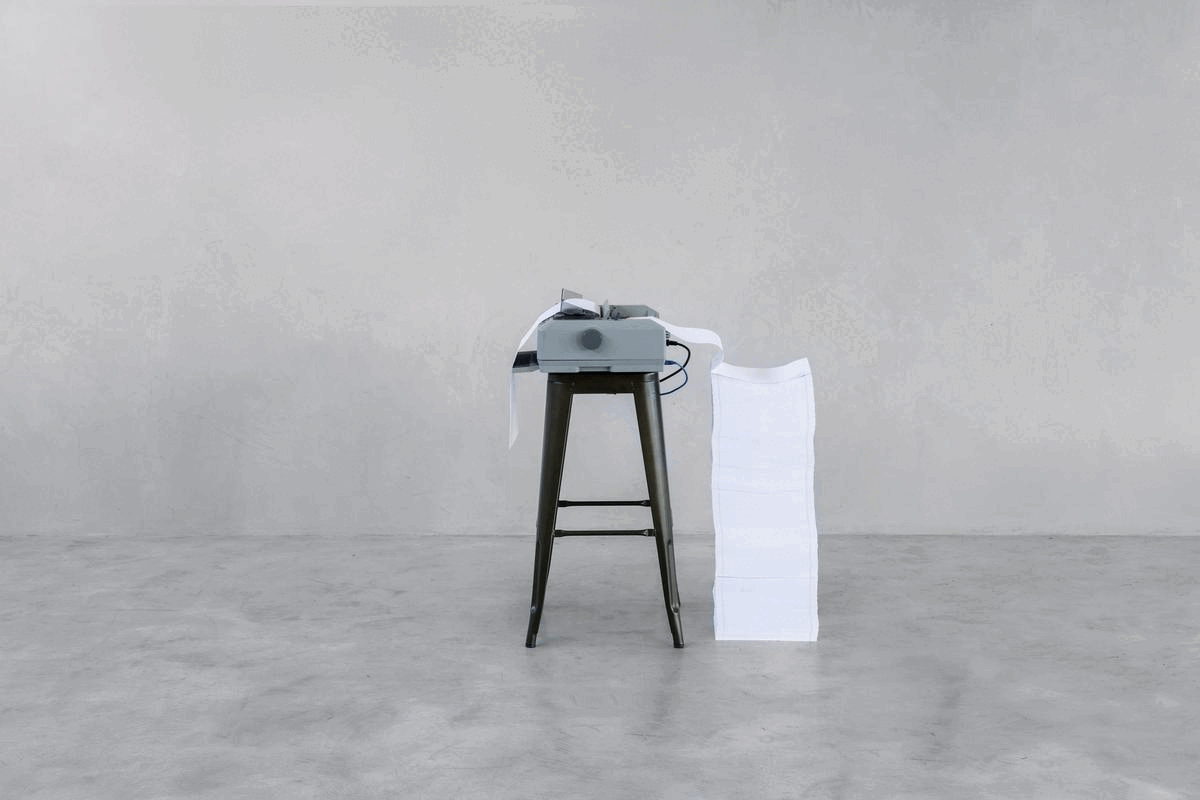

As if that were not enough, reports proved that the Brazilian Armed Forces had used public money to acquire more than 35 thousand units of sildenafil, a medicine known by the commercial name of Viagra. Moreover, it was bought with the implausible justification that it would be used in the treatment of military personnel with uma rare disease called pulmonary arterial hypertension which affects more women than men, among other inconsistencies.(3)

Viagra, 2023, part of the series Checked Headlines.
Photograph by Estúdio em Obra.
Photograph by Estúdio em Obra.
Another artwork from this first moment is the installation Inumeráveis,
composed of a dot matrix printer that prints, at a constant pace,
at least 12,000 life stories of Covid-19 victims in Brazil,
gathered previously by the Inumeráveis Memorial, a digital platform
which has hundreds of volunteers since 2020.
You can read all the stories here.
You can read all the stories here.

Inumeráveis, 2023. The installation is composed of a dot matrix printer
and 12 thousand sheets of continuous paper. Photograph by Estúdio Em Obra.
and 12 thousand sheets of continuous paper. Photograph by Estúdio Em Obra.
Each new story that is added to the Inumeráveis platform is
also printed by the machine. Using objects
that refer to bureaucratic and administrative processes,
here used acidly as symbols of governmental instances
which were theoretically responsible for protecting the population,
the work creates fragile impressions that physically safeguard the memory
of the Covid-19 victims.


Details of Inumeráveis, 2023. The installation is composed of a dot matrix printer
and 12 thousand sheets of continuous paper. Photograph by Estúdio Em Obra.
and 12 thousand sheets of continuous paper. Photograph by Estúdio Em Obra.
These impressions, which resemble everyday reports from a public office,
ready to be cataloged and shelved, however, are so large that archiving
them becomes impossible. As they are linked, page by page, they are indivisible.
It is necessary to understand them as a whole, united, a group of stories interrupted
by the same period. From North to South, East to West, each story is unique, and
holds a piece of wisdom that is not only priceless, but irreplaceable.

Inumeráveis, 2023. The installation is composed of a dot matrix printer
and 12 thousand sheets of continuous paper. Photograph by Estúdio Em Obra.
and 12 thousand sheets of continuous paper. Photograph by Estúdio Em Obra.
The silence
In the context of the Covid-19 pandemic, the clash between beliefs became latent. That is: the choice of what to believe, what information to take as true, determined individual, family and collective paths, including at the State level.
The artwork Believer postulates directions for understanding this scenario by transforming into ceramics one of the greatest icons of the pandemic period, the personal protective equipment called "face shield", usually made of transparent plastic.
In the context of the Covid-19 pandemic, the clash between beliefs became latent. That is: the choice of what to believe, what information to take as true, determined individual, family and collective paths, including at the State level.
The artwork Believer postulates directions for understanding this scenario by transforming into ceramics one of the greatest icons of the pandemic period, the personal protective equipment called "face shield", usually made of transparent plastic.

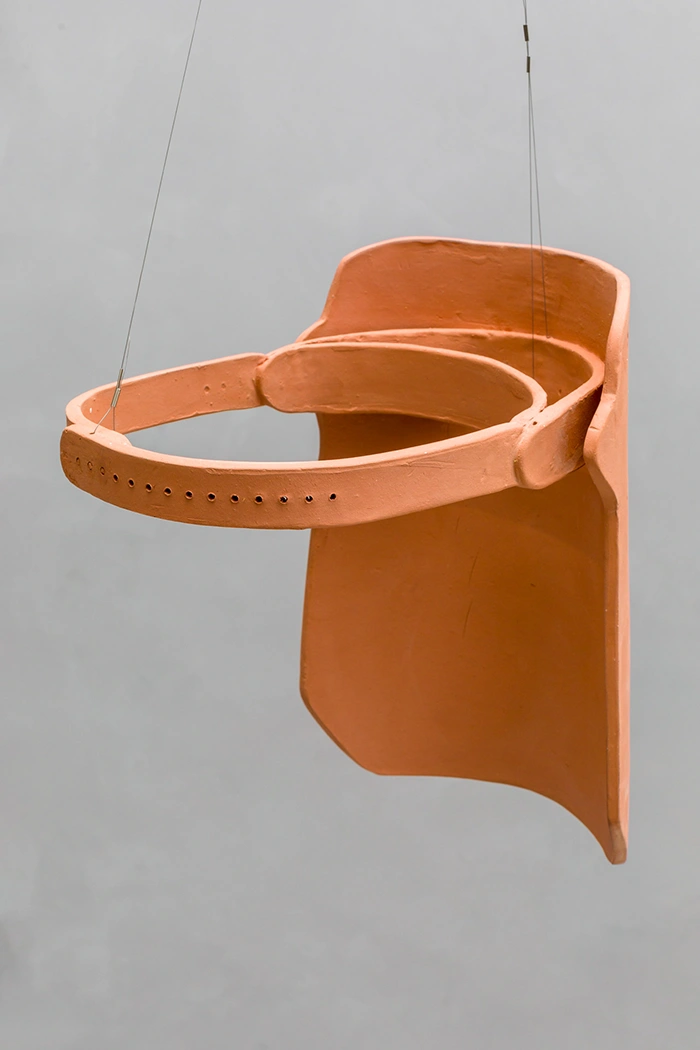
Believer, 2023. Ceramic sculpture, produced by Felipe Corcione.
Photograph by Estúdio Em Obra.
Photograph by Estúdio Em Obra.
By transforming it into ceramics, one of the materials through which we can learn
details of civilizations that existed thousands of years ago, the artist seeks to
solidify the era of the pandemic. With that, on the one hand, he immortalizes the
health workers who used the accessory every day on the front line of the fight against
the disease, and whose practice was based on scientific methods.
On the other hand, the transformation into ceramics makes it impossible for the instrument to fulfill its original function, and is now a physical obstacle to vision. Like radical blinkers, the object questions the way in which faith is built within each person. It questions, more specifically, the senses we use to elaborate our conceptions about the world and about the truth.
On the other hand, the transformation into ceramics makes it impossible for the instrument to fulfill its original function, and is now a physical obstacle to vision. Like radical blinkers, the object questions the way in which faith is built within each person. It questions, more specifically, the senses we use to elaborate our conceptions about the world and about the truth.
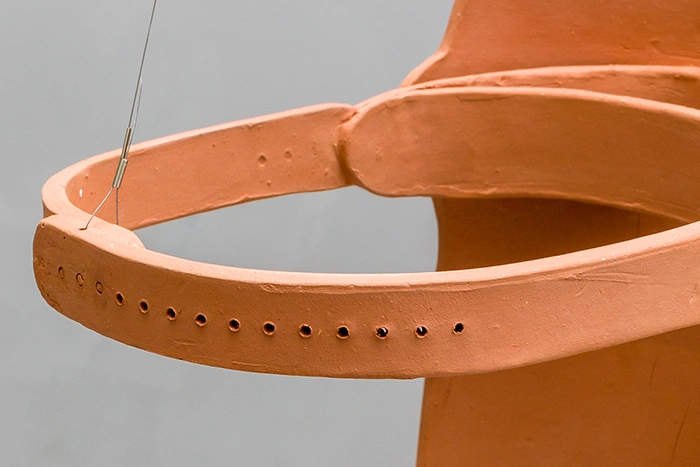
Details of Believer, 2023. Ceramic sculpture, produced by Felipe Corcione.
Photograph by Estúdio Em Obra.
Photograph by Estúdio Em Obra.
The music
In The Music, Pavoni presents two works that are related with the final phase of the grieving process: Orbital Temple and First Sense.
Templo Orbital is the first orbital artistic satellite of the Global South. Its mission is to question symbolic colonization of heaven as paradise; the origin of the rules that open or close your portals; and the influence these beliefs have on the decisions we make every day.
In The Music, Pavoni presents two works that are related with the final phase of the grieving process: Orbital Temple and First Sense.
Templo Orbital is the first orbital artistic satellite of the Global South. Its mission is to question symbolic colonization of heaven as paradise; the origin of the rules that open or close your portals; and the influence these beliefs have on the decisions we make every day.

Orbital Temple. Installation with satellite and golden sculpture.
Photograph by Estúdio Em Obra.
Photograph by Estúdio Em Obra.
Its starting point is acceptance, and it takes heaven as the ultimate place of acceptance.
Most cultures and religions that conform to some idea of heaven and hell establish precise
guidelines about who belongs to which destination in the afterlife. These guidelines are often
strict and exclusionary. The Orbital Temple mission questions these ideas. What if we could
imagine an alternate paradise in which all sentient beings could have a place? Through the website,
anyone can send the name of the person they want to send to heaven, at no cost. Once the satellite
is in orbit and the next alignment between it and the antenna takes place, the names will be
transmitted to the device in the sky. The satellite will store it in its memory and respond with a
message confirming that it is indeed registered in the temple.
Know more about the work here.
Know more about the work here.

Orbital Temple. Installation with satellite and golden sculpture.
Photograph by Estúdio Em Obra.
Photograph by Estúdio Em Obra.
The artwork First Sense,
which has been developed since 2015, gained new meanings
in the midst of the pandemic. That is when touch, as a basic need,
became increasingly evident due to the
its absence. During this period, touch became
a threat. The act of touching meant something dangerous,
risky, something to be feared and avoided. In this
increasingly acute touching crisis, its
consequences are yet to be estimated. That
extreme reduction in our ability to touch
others highlighted the fact that all people,
no matter their age, need to be touched in order to thrive.
The photographic series First Sense comes to the
encounter of the music by representing human responses to this once so fearsome touch.

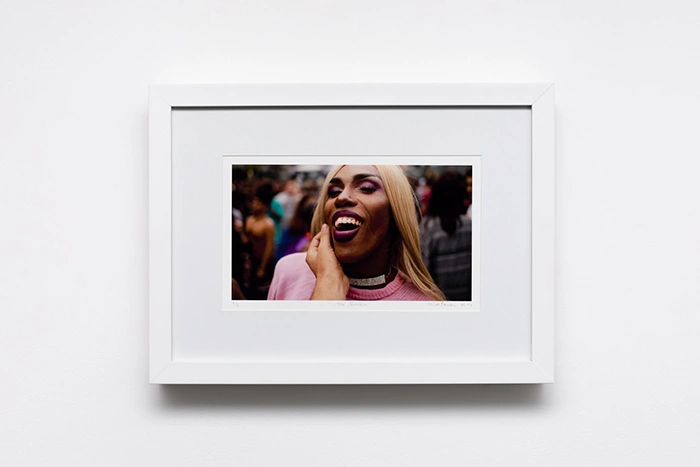
Cabo Verde Witch, 2019, and The Queen, 2023, part of the series First Sense.
Photograph by Estúdio Em Obra.
Photograph by Estúdio Em Obra.
Seeking to investigate the quality of the connections that arise from this act,
Pavoni photographically records the act of touching people for the first time,
some which were unknown and others that were already familiar to him.
In this movement, Pavoni seeks to
understand the spirit of touch, our most basic communication tool.
Capable of conveying emotions faster than words, even the most sublte touch
can have profound effects on how we feel, triggering a range of emotions
so complex and broad that it manages to define, little by little, who we are.
Know more about the series here.
Know more about the series here.
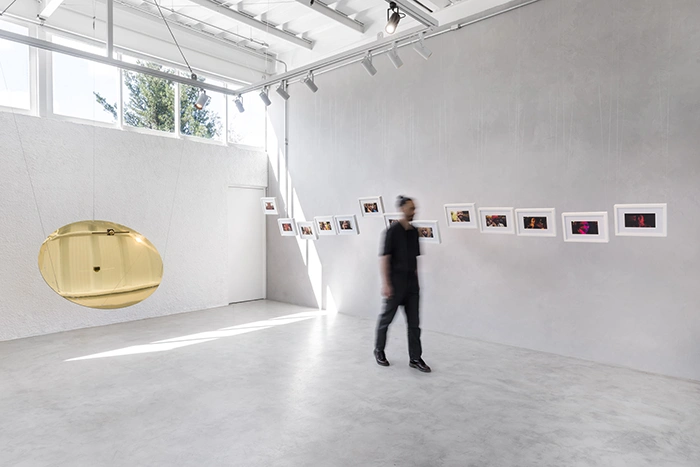
The music, a part of the exhibition
What we cannot forget, 2023.
Photograph by Estúdio Em Obra.
The performance
Photograph by Estúdio Em Obra.
Those who found themselves at Casa Cósmica, in São Paulo, when the clocks ticked
five hours and fifty-five minutes, on June 17, 2023,
could participate in the performance What we cannot forget, result
of a collaborative process between Isabella Nardini and Edson Pavoni.
Among the other works in the exhibition of the same name, which explored
the collective trauma of the Covid-19 pandemic in Brazil, there was a
simplicity in the auxiliary elements — the performance relied on a
hourglass, suspended from the ceiling, two chairs facing each other,
and small red ribbons, delicate as if they were going to give the final touch
to a nice gift.
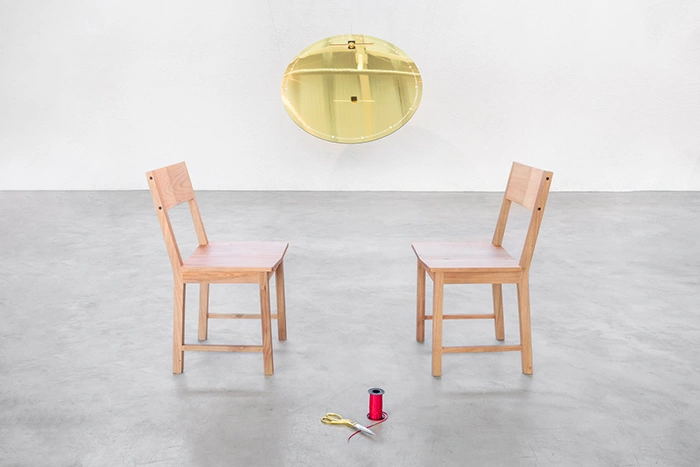
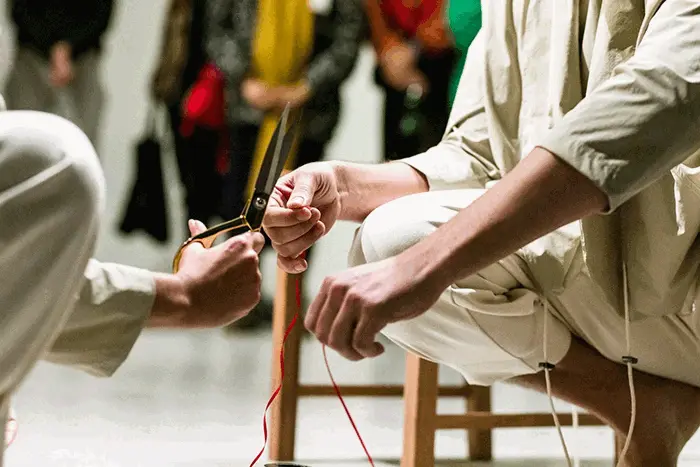


Photographs of the performance What we cannot forget, 2023. By Isabella Nardini e Edson Pavoni.
Images by Estúdio Em Obra.
Images by Estúdio Em Obra.
Nardini and Pavoni, in this performance, elaborate an invitation so
that other participants can exercise their memory not only
as a collective action, but as a shared responsibility.
The simplicity of the question they were invited to answer, “what
can we not forget?”, also carried with it the depth of a
questioning that seems to be at the most fundamental basis of any
decision. Answers pointed
to the need to reflect on memory policiesthat permeate our
relationship with the past, the present and
the future. After Nardini and Pavoni answered the question, each of them made a
loop with the ribbon on a finger of the other. And then they passed two more
ribbons so that new bodies would occupy that space and follow
interweaving.
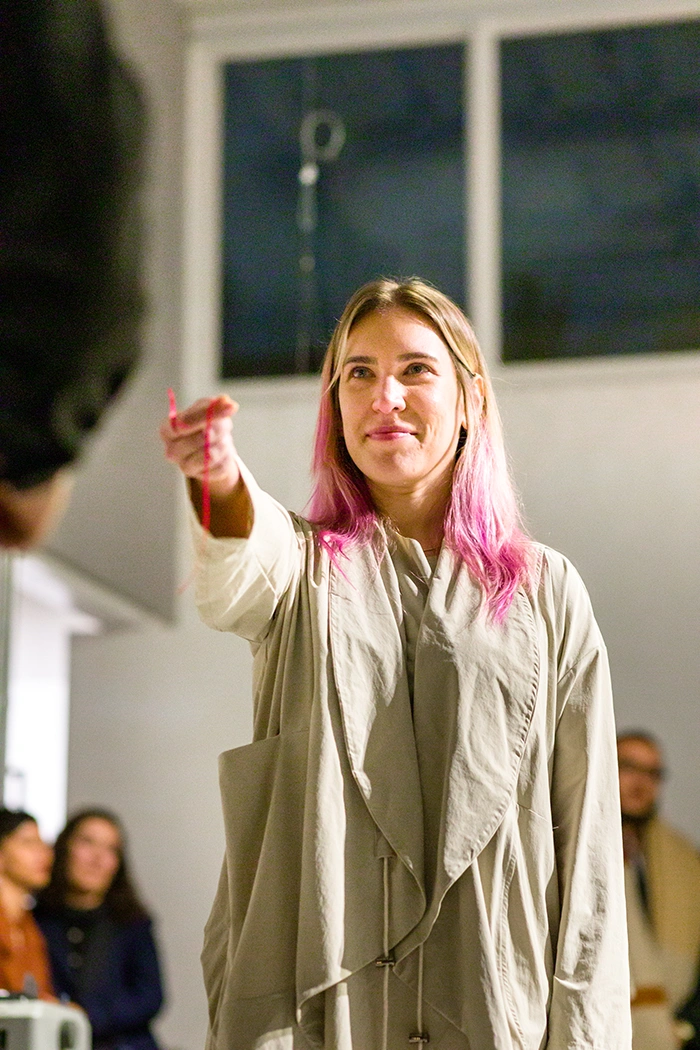

Isabella Nardini during the performance What we cannot forget, 2023.
Photograph by Estúdio Em Obra.
Photograph by Estúdio Em Obra.
By encouraging participants to take
the seats in the middle of the art show, as the hourglass turned,
and share what was essential for them to remember,
the performance acted in an almost metalinguistic way
by demanding, itself, that the act of remembering be
exercised. Thus, it took the audience's bodies as
protagonists of this act and, in this context, the immediate connection that arose, between two
previously unknown to each other, was
evident. Strangers who were willing to find a common ground.

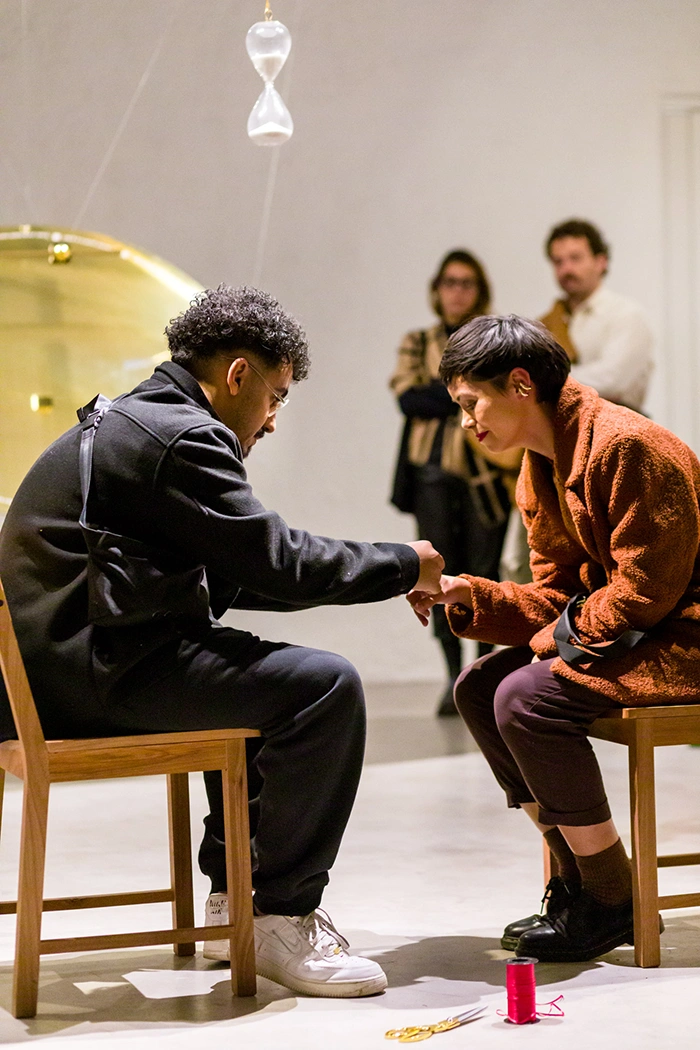


Photographs of the performance What we cannot forget, 2023. By Isabella Nardini e Edson Pavoni.
Images by Estúdio Em Obra.
Images by Estúdio Em Obra.
Credits
Edson Pavoni, artist
Curator
Carollina Lauriano
Performance
Isabella Nardini & Edson Pavoni
Guest Speaker
Ana Claudia Quintana
Set up
Gabriela Veiga & Junior de Gois
Production
Clara Marques & Gabriela Veiga
Texts & Graphic Design
Clara Marques
Photography & Video
Estúdio Em Obra
Special thanks to
Casa Cósmica, Felipe Corcione, Anelise Valls, Marcello Dantas & Matias Campos Abad.
Orbital Temple Team Pedro Kaled, João Pedro Polito, Victor Baptista, João Victor Alves, André Biagioni, VK, Jonathan Querubina, Guilherme Bullejos, Eduardo Dias, RiseNy&Partners, Roberta Savian Rosa, Clara Marques, Daphne Alves, IdeaSpace & Pearmill.
Edson Pavoni, artist
Curator
Carollina Lauriano
Performance
Isabella Nardini & Edson Pavoni
Guest Speaker
Ana Claudia Quintana
Set up
Gabriela Veiga & Junior de Gois
Production
Clara Marques & Gabriela Veiga
Texts & Graphic Design
Clara Marques
Photography & Video
Estúdio Em Obra
Special thanks to
Casa Cósmica, Felipe Corcione, Anelise Valls, Marcello Dantas & Matias Campos Abad.
Orbital Temple Team Pedro Kaled, João Pedro Polito, Victor Baptista, João Victor Alves, André Biagioni, VK, Jonathan Querubina, Guilherme Bullejos, Eduardo Dias, RiseNy&Partners, Roberta Savian Rosa, Clara Marques, Daphne Alves, IdeaSpace & Pearmill.